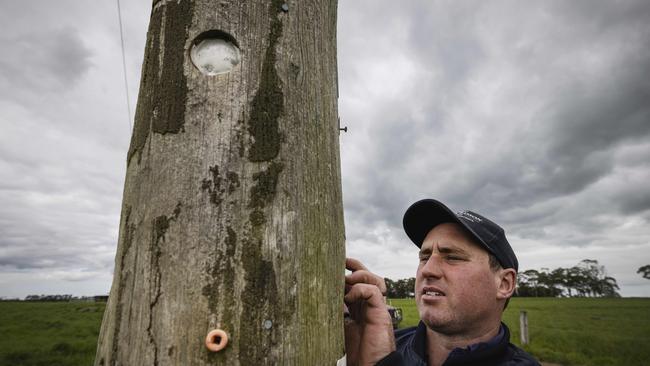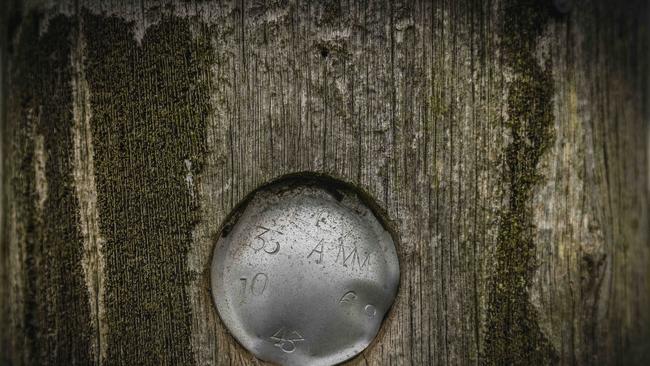Fears over rotten power poles in western Victoria’s highest bushfire-risk zones
More than 100,000 ageing power poles, delivering electricity to western Victoria’s highest bushfire-risk zones, are at risk of rot and collapse.

Victoria
Don't miss out on the headlines from Victoria. Followed categories will be added to My News.
More than 100,000 ageing messmate power poles delivering electricity to western Victoria’s highest bushfire-risk zones are at risk of rot and collapse, locals and the state’s safety regulator fear.
Energy Safe Victoria and electricity distributor Powercor reported as far back as January last year they needed to replace or reinforce at least 39,770 poles from 2021 to 2026, in a bid to minimise the risk of them failing and starting fires.
ESV warned power-pole failures were on the rise and said the situation would only get worse.
The regulator’s analysis has shown a wave of ageing Powercor poles would push the number installed more that 50 years ago to 200,000 by 2023, with almost 80,000 of those more than 60 years old.
“The number of wooden pole failures shows an increasing trend over the last few years,” ESV reported. “Without intervention the failure rate will continue to increase as poles age.”
“The major causes of unassisted wooden pole failure are rot decay (50 per cent) followed by weather (31 per cent) and termites (16 per cent).”
Less than a fortnight ago a rotten power pole at Pomborneit collapsed, sparking a frightening display that a local telco technician caught on video on a line that was responsible for sparking the March 2018 St Patrick’s Day fires.
ESV technical reports have found the old state-owned SEC installed 126,000 messmate poles across what would become Powercor’s footprint from 1956 to 1984, 12,000 class-three mountain grey gums poles, plus 54,000 of “unknown” origin.
The Standards Australia rating for untreated messmate poles states their nominal below-ground life is five to 15 years, while the above ground life is seven to 15 years.
While the SECV treated poles, local farmers and the timber industry say they have long known messmate is difficult to impregnate with preservatives and is highly vulnerable to internal rot.

Ecklin South dairy farmer Simon Craven said messmate was widely regarded as useless for fence posts.
“They (farmers) used messmate for fencing for a while, but everyone found it was useless,” he said.
Mr Craven and other farmers across the state’s west back the ESV’s warnings, arguing there are thousands of poles full of internal rot that desperately need replacing.
Yet despite ESV’s call to action the Australian Energy Regulator earlier this year rejected Powercor’s original request to claim back $234 million from its customers to cover the cost of replacing and reinforcing 39,770 poles, cutting that amount to just $148m to cover 22,361 poles.
“We have concluded that its forecast materially overstates expenditure required to maintain the safety and reliability of Powercor’s poles network,” the AER ruled.
AER chair Clare Savage said “affordability, safety, reliability and economic efficiency are the crucial components in our decision-making to protect consumers and ensure they are better off now and in the future”.
In its final determination, the AER stated its final decision “does not preclude Powercor from spending more than our forecast”, but outside the regulated tariffs it charged customers.
But the Chinese majority shareholders in Powercor, CK Infrastructure, appear to be resisting dipping into its profits to cover the shortfall.
The AER also revealed that between 2016 and 2020 “Powercor didn’t replace the poles that they said they would”, exacerbating the problem.
In responding to questions on the issue Powercor spokesman Jordan Oliver said “we were disappointed our proposal was not supported” by the AER.
Powercor has cranked up its inspections of power-poles, but is still falling well short of ESV expectations on replacing them.

ESV spokesman Jonathan Granger said the pole replacement and reinforcement program outlined in Powercor’s 2021 bushfire mitigation plan (at 22,361 poles) was still insufficient to meet community safety outcomes.
“ESV has requested that Powercor resubmit its Bushfire Mitigation Plan by 1 December to reflect the increased number of power poles to be replaced,” Mr Granger said.
He said ESV now wanted Powercor to replace and reinforce at least 34,650 poles over the next five years.
“This is required to reduce the bushfire risk resulting from unsustainable wood pole management practices and will need to be sustained over a 20 year period to return Powercor to the levels of age-based risk present, before failures began rising to an unacceptable level,” Mr Granger said.
Mr Craven said last Fritday AER officers told him they would not be revisiting the issue for five years, when the next pricing determination was due.
Originally published as Fears over rotten power poles in western Victoria’s highest bushfire-risk zones



